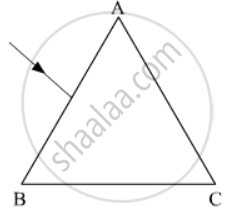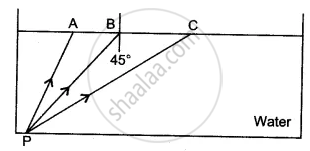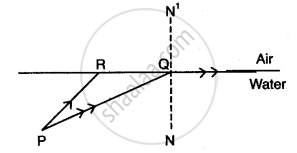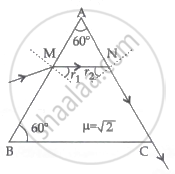Advertisements
Advertisements
प्रश्न
Answer the following question.
Define the critical angle of incidence and obtain an expression for it.
उत्तर
- The critical angle for a pair of refracting media can be defined as that angle of incidence in the denser medium for which the angle of refraction in the rarer medium is 90°.
- Let n be the relative refractive index of a denser medium with respect to the rarer.
- Then, according to Snell’s law,
n = `"n"_"denser"/"n"_"rarer"=(sin"r")/(sin"i"_"c")=(sin90°)/(sin"i"_"c")`
∴ sin (ic) = `1/"n"`
APPEARS IN
संबंधित प्रश्न
State the conditions required for total internal reflection of light to take place
Name the factors affecting the critical angle for the pair of media.
The figure shows a ray of light falling normally on the face AB of an equilateral glass prism having refractive index`3/2`, placed in water of refractive index `4/3`.Will this ray suffer total internal reflection on striking the face AC? Justify your answer.

State the relation between the critical angle and the absolute refractive index of a medium.
Total internal reflection occurs only when a ray of light passes from a ______ medium to a ______ medium.
Write the necessary conditions for the phenomenon of total internal reflection to
occur ?
Make the correct choices for each of the following :
Total Internal reflection takes place when
(where ∠i = angle of incidence, ∠r = angle of refraction, ∠C = critical angle)
How does a ray of light bend when it travels from when it is normal to the interface of the two media.
Express the refractive index μ of a medium in terms of the angle of incidence i in air and the angle of refraction r in a denser medium.
How are critical angles related to the refractive index of the medium?
State two advantages of using a right-angle prism as a reflector, rather than a plane mirror.
A ray of light incident at an angle of incidence ‘i’ passes through an equilateral glass prism such that the refracted ray inside the prism is parallel to its base and emerges from the prism at an angle of emergence ‘e’.
How is the angle of emergence ‘e’ related to the angle of incidence ‘i’?
What is meant by the statement, ‘the critical angle for diamond is 24°’?
The diagram shows a point source P inside a water container. Three rays A, B, and C starting from P are shown up to the water surface. Show in the diagram the path of these rays after striking the water surface. The critical angle for the water-air pair is 48°.

PQ and PR are two light rays emerging from the object as shown in the figure below:

(i) What is the special name given to the angle of incidence (∠PQN) of ray PQ?
(ii) Copy the ray diagram and complete it to show the position of the image of the object P when seen obliquely from above.
(iii) Name the phenomenon that occurs if the angle of incidence ∠PQN is increased still further.
A spherical marble, of refractive index 1.5 and curvature 1.5 cm, contains a tiny air bubble at its centre. Where will it appear when seen from outside?
Choose the correct option.
Select the WRONG statement.
Which of the following is not involved in formation of a rainbow?
Answer the following question.
Under what conditions are total internal reflection possible? Explain it with a suitable example.
Solve Numerical example.
A monochromatic ray of light is incident at 37° on an equilateral prism of refractive index 3/2. Determine angle of emergence and angle of deviation. If angle of prism is adjustable, what should its value be for emergent rays to be just possible for the same angle of incidence?
For total internal reflection to take place, the angle of inddence i and the refractive index µ of the medium must satisfy the inequality ____________.
What are the conditions to achieve total internal reflection?
Write any two uses of total internal reflection.
A ray of light passes through a prism of refractive index `sqrt2` as shown in the figure. Find:

- The angle of incidence (∠r2) at face AC.
- The angle of minimum deviation for this prism.
Which of the following is used in optical fibres?
Find the value of θ in the given figure.

